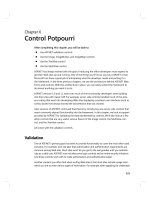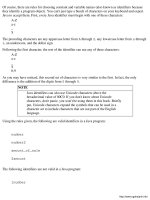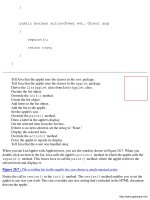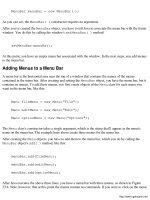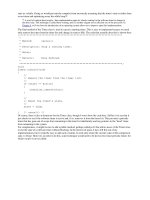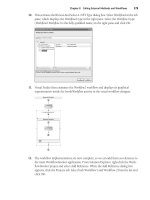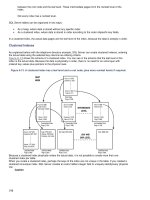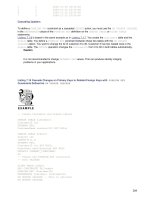programming XML by Example phần 6 pot
Bạn đang xem bản rút gọn của tài liệu. Xem và tải ngay bản đầy đủ của tài liệu tại đây (303.81 KB, 53 trang )
if(args.length < 2)
{
System.out.println(“java com.psol.xbe.BestDeal filename delivery”);
return;
}
ComparingMachine comparingMachine =
new ComparingMachine(Integer.parseInt(args[1]));
SAX2Internal sax2Internal =
new SAX2Internal(comparingMachine);
try
{
Parser parser = ParserFactory.makeParser(PARSER_NAME);
parser.setDocumentHandler(sax2Internal);
parser.parse(args[0]);
}
catch(SAXException e)
{
Exception x = e.getException();
if(null != x)
throw x;
else
throw e;
}
System.out.println(“The best deal is proposed by “ +
comparingMachine.getVendor());
System.out.println(“a “ +
comparingMachine.getProductName() +
“ at “ + comparingMachine.getPrice() +
“ delivered in “ +
comparingMachine.getDelivery() +
“ days”);
}
}
250
Chapter 8: Alternative API: SAX
Listing 8.4: continued
10 2429 CH08 11/12/99 1:09 PM Page 250
/**
* This class receives events from the SAX2Internal adapter
* and does the comparison required.
* This class holds the “business logic.”
*/
class ComparingMachine
{
/**
* properties we are collecting: best price
*/
protected double bestPrice = Double.MAX_VALUE;
/**
* properties we are collecting: delivery time
*/
protected int proposedDelivery = Integer.MAX_VALUE;
/**
* properties we are collecting: product and vendor names
*/
protected String productName = null,
vendorName = null;
/**
* target delivery value (we refuse elements above this target)
*/
protected int targetDelivery;
/**
* creates a ComparingMachine
* @param td the target for delivery
*/
public ComparingMachine(int td)
{
targetDelivery = td;
}
251
Maintaining the State
continues
10 2429 CH08 11/12/99 1:09 PM Page 251
/**
* called by SAX2Internal when it has found the product name
* @param name the product name
*/
public void setProductName(String name)
{
productName = name;
}
/**
* called by SAX2Internal when it has found a price
* @param vendor vendor’s name
* @param price price proposal
* @param delivery delivery time proposal
*/
public void compare(String vendor,double price,int delivery)
{
if(delivery <= targetDelivery)
{
if(bestPrice > price)
{
bestPrice = price;
vendorName = vendor;
proposedDelivery = delivery;
}
}
}
/**
* property accessor: vendor’s name
* @return the vendor with the cheapest offer so far
*/
public String getVendor()
{
return vendorName;
}
252
Chapter 8: Alternative API: SAX
Listing 8.4: continued
10 2429 CH08 11/12/99 1:09 PM Page 252
/**
* property accessor: best price
* @return the best price so far
*/
public double getPrice()
{
return bestPrice;
}
/**
* property accessor: proposed delivery
* @return the proposed delivery time
*/
public int getDelivery()
{
return proposedDelivery;
}
/**
* property accessor: product name
* @return the product name
*/
public String getProductName()
{
return productName;
}
}
/**
* SAX event handler to adapt from the SAX interface to
* whatever the application uses internally.
*/
class SAX2Internal
extends HandlerBase
{
/**
253
Maintaining the State
continues
10 2429 CH08 11/12/99 1:09 PM Page 253
* state constants
*/
final protected int START = 0,
PRODUCT = 1,
PRODUCT_NAME = 2,
VENDOR = 3,
VENDOR_NAME = 4,
VENDOR_PRICE = 5;
/**
* the current state
*/
protected int state = START;
/**
* current leaf element and current vendor
*/
protected LeafElement currentElement = null,
currentVendor = null;
/**
* BestDeal object this event handler interfaces with
*/
protected ComparingMachine comparingMachine;
/**
* creates a SAX2Internal
* @param cm the ComparingMachine to interface with
*/
public SAX2Internal(ComparingMachine cm)
{
comparingMachine = cm;
}
/**
* startElement event
* @param name element’s name
254
Chapter 8: Alternative API: SAX
Listing 8.4: continued
10 2429 CH08 11/12/99 1:09 PM Page 254
* @param attributes element’s attributes
*/
public void startElement(String name,AttributeList attributes)
{
// this accepts many combinations of elements
// it would work if new elements where being added, etc.
// this ensures maximal flexibility: if the document
// has to be validated, a validating parser does it
switch(state)
{
case START:
if(name.equals(“product”))
state = PRODUCT;
break;
case PRODUCT:
if(name.equals(“name”))
{
state = PRODUCT_NAME;
currentElement = new LeafElement(name,attributes);
}
if(name.equals(“vendor”))
state = VENDOR;
break;
case VENDOR:
if(name.equals(“name”))
{
state = VENDOR_NAME;
currentElement = new LeafElement(name,attributes);
}
if(name.equals(“price”))
{
state = VENDOR_PRICE;
currentElement = new LeafElement(name,attributes);
}
break;
}
}
255
Maintaining the State
continues
10 2429 CH08 11/12/99 1:09 PM Page 255
/**
* content of the element
* @param chars documents characters
* @param start first character in the content
* @param length last character in the content
*/
public void characters(char[] chars,int start,int length)
{
switch(state)
{
case PRODUCT_NAME:
case VENDOR_NAME:
case VENDOR_PRICE:
currentElement.append(chars,start,length);
break;
}
}
/**
* endElement event
* @param name element’s name
*/
public void endElement(String name)
{
switch(state)
{
case PRODUCT_NAME:
if(name.equals(“name”))
{
state = PRODUCT;
comparingMachine.setProductName(
currentElement.getText());
}
break;
case VENDOR:
if(name.equals(“vendor”))
256
Chapter 8: Alternative API: SAX
Listing 8.4: continued
10 2429 CH08 11/12/99 1:09 PM Page 256
state = PRODUCT;
break;
case VENDOR_NAME:
if(name.equals(“name”))
{
state = VENDOR;
currentVendor = currentElement;
}
break;
case VENDOR_PRICE:
if(name.equals(“price”))
{
state = VENDOR;
double price = toDouble(currentElement.getText());
Dictionary attributes =
currentElement.getAttributes();
String stringDelivery =
(String)attributes.get(“delivery”);
int delivery = Integer.parseInt(stringDelivery);
comparingMachine.compare(currentVendor.getText(),
price,
delivery);
}
break;
}
}
/**
* helper method: turn a string in a double
* @param string number as a string
* @return the number as a double, or 0.0 if it cannot convert
* the number
*/
protected double toDouble(String string)
{
Double stringDouble = Double.valueOf(string);
if(null != stringDouble)
257
Maintaining the State
continues
10 2429 CH08 11/12/99 1:09 PM Page 257
return stringDouble.doubleValue();
else
return 0.0;
}
}
/*
* helper class: used to store a leaf element content
*/
class LeafElement
{
/**
* property: element’s name
*/
protected String name;
/**
* property: element’s attributes
*/
protected Dictionary attributes;
/**
* property: element’s text
*/
protected StringBuffer text = new StringBuffer();
/**
* creates a new element
* @param n element’s name
* @param a element’s attributes
*/
public LeafElement(String n,AttributeList al)
{
name = n;
attributes = new Hashtable();
for(int i = 0;i < al.getLength();i++)
attributes.put(al.getName(i),al.getValue(i));
258
Chapter 8: Alternative API: SAX
Listing 8.4: continued
10 2429 CH08 11/12/99 1:09 PM Page 258
}
/**
* append to the current text
* @param chars array of characters
* @param start where to start in chars
* @param length how many characters to consider in chars
*/
public void append(char[] chars,int start,int length)
{
text.append(chars,start,length);
}
/**
* property accessor: text
*/
public String getText()
{
return text.toString();
}
/**
* property accessor: name
*/
public String getName()
{
return name;
}
/**
* property accessor: attributes
*/
public Dictionary getAttributes()
{
return attributes;
}
}
259
Maintaining the State
10 2429 CH08 11/12/99 1:09 PM Page 259
You compile and run this application just like the “Cheapest” application
introduced previously. The results depend on the urgency of the delivery.
You will notice that this program takes two parameters: the filename and
the longest delay.
java -classpath c:\xml4j\xml4j.jar;classes com.psol.xbe.BestDeal
➥product.xml 60
returns
The best deal is proposed by XMLi
a XML Training at 699.0 delivered in 45 days
whereas
java -classpath c:\xml4j\xml4j.jar;classes com.psol.xbe.BestDeal
➥product.xml 3
returns
The best deal is proposed by Emailaholic
a XML Training at 1999.0 delivered in 2 days
A Layered Architecture
Listing 8.4 is the most complex application you have seen so far. It’s logical:
The SAX parser is very low level so the application has to take over a lot of
the work.
The application is organized around two classes: SAX2Internal and
ComparisonMachine. SAX2Internal manages the interface with the SAX
parser. It manages the state and groups several elements in a coherent
way. For that purpose, it uses the LeafElement class as temporary storage.
ComparisonMachine has the logic to perform price comparison. It also main-
tains information in a structure that is optimized for the application, not
XML. The architecture for this application is illustrated in Figure 8.7.
SAX2Internal handles several events from DocumentHandler. It registers the
startElement, endElement, and character events.
260
Chapter 8: Alternative API: SAX
OUTPUT
10 2429 CH08 11/12/99 1:09 PM Page 260
Figure 8.7: The architecture for the application
When processing these events, SAX2Internal needs to know where it is in
the document tree. When handling a character event, for example, it needs
to know whether the text is attached to a name or to a price element. It
also needs to know whether the name is the product name or the vendor
name.
States
A SAX parser, unlike a DOM parser, does not provide context information.
Therefore, the application has to track its location within the document.
First, you have to identify all possible states and determine how to transi-
tion from one state to the next. It’s easy to derive states from the document
structure in Figure 8.6.
It is obvious that the application will first encounter a product tag. The
first state should therefore be “within a product element.” From there, the
application will reach a product name. The second state is therefore “within
a name element in the product element.”
The next element has to be a vendor, so the third state is “within a vendor
element in the product element.” The fourth state is “within a name ele-
ment in a vendor element in a product element” because a name follows the
vendor.
The name is followed by a price element and the corresponding state is
“within a price element in a vendor element in a product element.”
Afterward, the parser will encounter either a price element or another
vendor element. You already have state for these two cases.
It’s easier to visualize this concept on a graph with state and state transi-
tions, such as the one shown in Figure 8.8. Note that there are two differ-
ent states related to two different name elements depending on whether
you are dealing with the product/name or product/vendor/name.
261
Maintaining the State
10 2429 CH08 11/12/99 1:09 PM Page 261
Figure 8.8: State transition diagram
In the example, the state variable is the current state:
/**
* state constants
*/
final protected int START = 0,
PRODUCT = 1,
PRODUCT_NAME = 2,
VENDOR = 3,
VENDOR_NAME = 4,
VENDOR_PRICE = 5;
/**
* the current state
*/
protected int state = START;
Transitions
1. The value of state changes in response to events. Specifically, in the
example,
elementStart and elementEnd cause the state to transition:
switch(state)
{
case START:
if(name.equals(“product”))
262
Chapter 8: Alternative API: SAX
EXAMPLE
EXAMPLE
10 2429 CH08 11/12/99 1:09 PM Page 262
state = PRODUCT;
break;
case PRODUCT:
if(name.equals(“name”))
{
state = PRODUCT_NAME;
currentElement = new LeafElement(name,attributes);
}
if(name.equals(“vendor”))
state = VENDOR;
break;
case VENDOR:
if(name.equals(“name”))
{
state = VENDOR_NAME;
currentElement = new LeafElement(name,attributes);
}
if(name.equals(“price”))
{
state = VENDOR_PRICE;
currentElement = new LeafElement(name,attributes);
}
break;
}
}
SAX2Internal creates instances of LeafElement to temporarily store the con-
tent of the name and price elements. At any time, SAX2Internal maintains a
small subset of the tree in memory. Note that, unlike DOM, it never builds
the complete tree but builds only small subsets. It also discards the subset
as the application consumes them.
CAUTION
The values in AttributeList are available only during the startElement event.
Consequently, LeafElement copies them to a Dictionary.
2. The character event is used to record the content of an element. It
makes sense to record text only in the
name and price elements, so the
event handler uses the state.
263
Maintaining the State
EXAMPLE
10 2429 CH08 11/12/99 1:09 PM Page 263
switch(state)
{
case PRODUCT_NAME:
case VENDOR_NAME:
case VENDOR_PRICE:
currentElement.append(chars,start,length);
break;
}
3. The event handler for the endElement event updates the state and
calls ComparisonMachine. ComparisonMachine consumes the data
switch(state)
{
case PRODUCT_NAME:
if(name.equals(“name”))
{
state = PRODUCT;
comparingMachine.setProductName(
currentElement.getText());
}
break;
case VENDOR:
if(name.equals(“vendor”))
state = PRODUCT;
break;
case VENDOR_NAME:
if(name.equals(“name”))
{
state = VENDOR;
currentVendor = currentElement;
}
break;
case VENDOR_PRICE:
if(name.equals(“price”))
{
state = VENDOR;
double price = toDouble(currentElement.getText());
Dictionary attributes =
currentElement.getAttributes();
264
Chapter 8: Alternative API: SAX
10 2429 CH08 11/12/99 1:09 PM Page 264
String stringDelivery =
(String)attributes.get(“delivery”);
int delivery = Integer.parseInt(stringDelivery);
comparingMachine.compare(currentVendor.getText(),
price,
delivery);
}
break;
}
Lessons Learned
Listing 8.4 is typical for a SAX application. The SAX event handler pack-
ages the data in the format most appropriate for the application. It might
have to build a partial tree (in this case, using LeafElement) in the process.
The application logic (in ComparisonMachine) is totally unaware of XML. As
far as it is concerned, the data could be coming from a database or a
comma-delimited file.
Because of this clean-cut separation between the application logic and the
parsing, it is a good idea to adopt a layered approach and use a separate
class for the event handler.
The example also clearly illustrates that SAX is more efficient than DOM
but it requires more work from the programmer. With a SAX parser, the
programmer has to explicitly manage states and transitions between states.
With DOM, the state was implicit in the recursive walk of the tree.
Flexibility
XML is a very flexible standard. However, in practice, XML applications are
only as flexible as you, the programmer, make them. In this section, we will
look at some tips to ensure your applications exploit XML flexibility.
Build for Flexibility
This application puts very few constraints on the structure of the underly-
ing document. It simply ignores new elements. For example, it would accept
the following
vendor element:
<vendor>
<name>Playfield Training</name>
<contact>John Doe</contact>
265
Flexibility
EXAMPLE
10 2429 CH08 11/12/99 1:09 PM Page 265
<price delivery=”5”>999.00</price>
<price delivery=”15”>899.00</price>
</vendor>
but it would ignore the contact information. In general, it’s a good idea to
simply ignore unknown elements. Doing so provides more flexibility when
the document evolves.
Enforce a Structure
It’s not difficult to enforce a specific structure. The following code snippet
checks the structure and throws a SAXException if a vendor element con-
tains anything but name or price elements.
case VENDOR:
if(name.equals(“name”))
{
state = VENDOR_NAME;
currentElement = new LeafElement(name,attributes);
}
else if(name.equals(“price”))
{
state = VENDOR_PRICE;
currentElement = new LeafElement(name,attributes);
}
else
throw new SAXException(“<name> or <price> expected”);
break;
In practice, if the application is really dependent on the structure of the
document, it is easier to write a DTD and use a validating parser.
What’s Next
In the previous chapter and in this chapter, you learned how to read XML
documents. In the next chapter, you learn how to write documents, thereby
closing the loop.
266
Chapter 8: Alternative API: SAX
EXAMPLE
10 2429 CH08 11/12/99 1:09 PM Page 266
10 2429 CH08 11/12/99 1:09 PM Page 267
11 2429 CH09 11/12/99 1:02 PM Page 268
9
Writing XML
In the last four chapters, you learned how to use XML documents in your
applications. You studied style sheets and how to convert XML documents
in HTML. You also learned how to read XML documents from JavaScript or
Java applications with a parser.
This chapter looks at the mirror problem: how to write XML documents
from an application. The mirror component for the parser is called a gener-
ator. Whereas the parser reads XML documents, the generator writes them.
In this chapter, you learn how to write documents
• through DOM, which is ideal for modifying XML documents.
• through your own generator, which is more efficient.
The Parser Mirror
In practice, some parsers integrate a generator. They can read and write
XML documents. Consequently, the term parser is often used to symbolize
the combination of the parser and the generator.
There are two schools of thought when it comes to generators:
• The first school argues that you need packaged generators for the
same reason you need packaged parsers: to shield the programmer
from the XML syntax.
• The other school argues that writing XML documents is simple and
can easily be done with ad hoc code.
As usual, I’m a pragmatist and I choose one option or the other depending
on the needs of the application at hand. In general, however, it is dramati-
cally easier to generate XML documents than to read them. This is because
you control what you write but the author controls what you read.
Indeed, when reading a document, you may have to deal not only with tags
but also with entities, exotic character sets, and notations—not to mention
errors and DTD validation.
11 2429 CH09 11/12/99 1:02 PM Page 269
However, when writing the document, you decide. If your applications don’t
need entities, don’t use them. If you are happy with ASCII, stick to it. Most
applications need few of the features of XML besides the tagging mecha-
nism.
Therefore, although a typical XML parser is a thousand lines of code, a sim-
ple but effective generator can be written in a dozen lines.
This chapter looks at both approaches. You’ll start by using a DOM parser
to generate XML documents and then you’ll see how to write your own gen-
erator. Finally, you will see how to support different DTDs.
The techniques are illustrated with JavaScript but port easily in to Java.
Modifying a Document with DOM
In Chapter 7, “The Parser and DOM,” you saw how DOM parsers read doc-
uments. That is only one half of DOM. The other half is writing XML docu-
ments. DOM objects have methods to support creating or modifying XML
documents.
Listing 9.1 is the XML price list used in Chapter 7.
✔ The example in the section “A DOM Application” in Chapter 7 (page 199) converted the
prices into Euros and printed the result.
With small changes to the original application, you can record the new
prices in the original document.
Listing 9.1: XML Price List
<?xml version=”1.0”?>
<products>
<product>
<name>XML Editor</name>
<price>499.00</price>
</product>
<product>
<name>DTD Editor</name>
<price>199.00</price>
</product>
<product>
<name>XML Book</name>
<price>19.99</price>
</product>
<product>
270
Chapter 9: Writing XML
EXAMPLE
11 2429 CH09 11/12/99 1:02 PM Page 270
<name>XML Training</name>
<price>699.00</price>
</product>
</products>
Listing 9.2 is the HTML form for a new version of the currency conversion
that will modify the XML file.
Listing 9.2: HTML Form for the Currency Converter
<HTML>
<HEAD>
<TITLE>Currency Conversion</TITLE>
<SCRIPT LANGUAGE=”JavaScript” SRC=”conversion.js”></SCRIPT>
</HEAD>
<BODY>
<CENTER>
<FORM ID=”controls”>
File: <INPUT TYPE=”TEXT” NAME=”fname”
VALUE=”prices.xml”>
Rate: <INPUT TYPE=”TEXT” NAME=”rate”
VALUE=”0.95274” SIZE=”4”><BR>
<INPUT TYPE=”BUTTON” VALUE=”Convert”
ONCLICK=”convert(controls,xml)”>
<INPUT TYPE=”BUTTON” VALUE=”Clear”
ONCLICK=”output.value=’’”><BR>
<! need one character in the text area >
<TEXTAREA NAME=”output” ROWS=”22” COLS=”70” READONLY>
</TEXTAREA>
</FORM>
<xml id=”xml”></xml>
</CENTER>
</BODY>
</HTML>
Listing 9.2 is familiar from Chapter 7. Listing 9.3 is the JavaScript file,
conversion.js, where the real action takes place. Figure 9.1 shows the
result in a browser.
271
Modifying a Document with DOM
11 2429 CH09 11/12/99 1:02 PM Page 271
Listing 9.3: JavaScript Code
function convert(form,xmldocument)
{
var fname = form.fname.value,
output = form.output,
rate = form.rate.value;
output.value = “”;
var document = parse(fname,xmldocument),
topLevel = document.documentElement;
walkNode(topLevel,document,rate);
addHeader(document,rate);
output.value = document.xml;
}
function parse(uri,xmldocument)
{
xmldocument.async = false;
xmldocument.load(uri);
if(xmldocument.parseError.errorCode != 0)
alert(xmldocument.parseError.reason);
return xmldocument;
}
function walkNode(node,document,rate)
{
if(node.nodeType == 1)
{
if(node.nodeName == “product”)
walkProduct(node,document,rate);
else
{
var children,
i;
272
Chapter 9: Writing XML
11 2429 CH09 11/12/99 1:02 PM Page 272
children = node.childNodes;
for(i = 0;i < children.length;i++)
walkNode(children.item(i),document,rate);
}
}
}
function walkProduct(node,document,rate)
{
if(node.nodeType == 1 && node.nodeName == “product”)
{
var price,
children,
i;
children = node.childNodes;
for(i = 0;i < children.length;i++)
{
var child = children.item(i);
if(child.nodeType == 1)
if(child.nodeName == “price”)
price = child;
}
// append the new child after looping to avoid infinite loop
var element = document.createElement(“price”),
text = document.createTextNode(getText(price) * rate);
element.setAttribute(“currency”,”eur”);
element.appendChild(text);
node.appendChild(element);
price.setAttribute(“currency”,”usd”);
}
}
function addHeader(document,rate)
{
var comment = document.createComment(
“Rate used for this conversion: “ + rate),
stylesheet = document.createProcessingInstruction(
“xml-stylesheet”,
273
Modifying a Document with DOM
continues
11 2429 CH09 11/12/99 1:02 PM Page 273
“href=\”prices.css\” type=\”text/css\””),
topLevel = document.documentElement;
document.insertBefore(comment,topLevel);
document.insertBefore(stylesheet,comment);
}
function getText(node)
{
return node.firstChild.data;
}
274
Chapter 9: Writing XML
Listing 9.3: continued
OUTPUT
Figure 9.1: Result in a browser
This example displays the XML document in a form. The section “Doing
Something with the XML Documents” explains how to save it.
Inserting Nodes
1. Most of Listing 9.3 is familiar. It walks through the price list and
converts prices from American dollars to Euros. The novelty is that it
inserts a new price element in the price list with the price in Euros.
It also adds a currency attribute to every price element.
EXAMPLE
11 2429 CH09 11/12/99 1:02 PM Page 274
